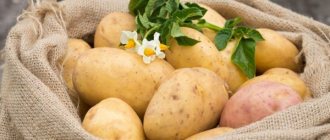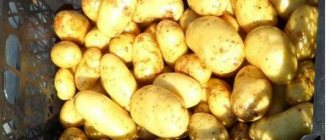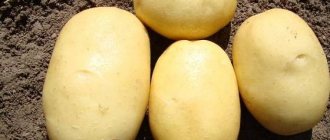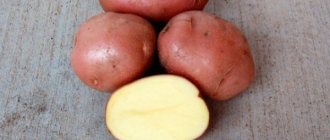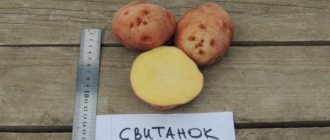History of the variety
Riviera potatoes are ultra-early varieties. The authors are Dutch agricultural breeders. They crossed 2 varieties - Minerva and Alkmaria. The crop appeared on potato plantations in Russia relatively recently, after being included in the State Register in 2013.
The variety is recommended for cultivation in the European part of Russia. But over the past 5 years, the geography of plantings has expanded significantly.
In regions with warm and temperate climates, when grown under film, gardeners receive 2 harvests per summer. Before selling, the Riviera variety must be washed.
Care
The "Riviera" variety is an unpretentious variety, but providing good and competent care increases the yield and quality of potatoes. How to care:
- Harrow potato plantings along the rows twice before mass shoots appear, and twice after shoots appear;
- The first time they hill up the potato tops with a hoe when the stems reach a height of 14-17 cm, the second time - two to three weeks after the first hilling;
REFERENCE: When nitrogen fertilizers are applied at a later date, the growth of green mass increases significantly, having a negative impact on the quality and quantity of the crop.
- Potato plantings are weeded well and regularly, and then the soil is loosened;
- If the leaves on the potato tops wither and the soil at a depth of five centimeters is dry, then it is necessary to water the plantings;
- Abundant rainfall and sufficient soil moisture, together with the use of dry fertilizers (bird droppings), mineral fertilizers and ash incorporated into the soil during hilling, give a good harvest.
Tasting Riviera potatoes:
Characteristics of the Riviera potato variety
The Riviera potato variety is distinguished by erect or slightly spreading stems with a height of 75 to 85 cm. The shoots, like the root system, are powerful, and rapid growth is observed at the initial stage of development.
The foliage of the bushes is average. The leaf blades are potato-type and can be medium or large. The inflorescences are white, with a pinkish or purple tint.
Attention! Not all gardeners can see the flowering of Riviera potatoes, since due to the precocity of the tubers, the inflorescences do not always bloom.
The tubers are oval or round in shape, depending on the looseness of the soil. The potato has a light beige skin with a slight roughness. The eyes are small, almost invisible, and lie shallow. The flesh is dense and creamy.
Up to 12 tubers are formed in each hole, weighing from 100 to 180 g. There is little starch in Riviera potatoes, only 12-15%, so it is recommended for baby and dietary food.
Fruit pests - table
| Pests | Description | Fighting methods |
| Colorado beetle | An adult beetle is similar to a ladybug, but with a different coloring - longitudinal black and yellow stripes. The larvae are bright orange. On one plant you can see different stages of development: eggs, larvae of different sizes and beetles. In such a neglected state, the bush is destroyed by pests in a couple of days, leaving only bare stems. Beetles overwinter in the ground. |
|
| Wireworm | Wireworms are the larvae of the click beetle. The beetle has an elongated brown, gray or black body about 3 cm long, some species grow up to 6 cm. The worms are orange and hard, which is why they got their name. Wireworms bite into potato tubers, feed on the pulp, and make numerous passages in it. | |
| Medvedka | The large orthopteran insect, 6 cm long, was named for its brown coloration, clumsiness and bear-like claws on its front paws. Other names: top - for the gray color of the larvae, earthen crayfish - for the presence of claws and cabbage - for the addiction to cabbage. For wintering, the insect digs vertical shafts up to 120 cm deep. The pest can be detected by burrows 1–2 cm in diameter and piles of earth nearby. In summer, in search of food, the mole cricket makes horizontal tunnels at a depth of 3–5 cm and eats everything that comes in its way: tubers, stolons, roots, stems. |
|
| Khrushchev or May beetle larvae | May beetles are large flying insects that live in the crowns of trees and fly towards the light at night. Their larvae cause great damage to root crops and potatoes. These are light-colored worms 4–7 cm long with a brown head and legs at the front of the body. The main feature is that the larvae are always curved in the shape of the letter “C”. Pests eat away the potato pulp along with the peel. The tubers look like apple cores. |
|
Photo gallery: the most dangerous potato pests
The Colorado potato beetle has a body shape similar to a lady's crust.
Colorado potato beetle larvae eat a potato bush
Often while weeding you can see the Nutcracker running through the garden bed.
Potatoes are perforated by wireworm, click beetle larva
The mole cricket is clumsy and brown, like a bear
Khrushchev and its larvae love soil fertilized with fresh manure
Pros and cons of the early Riviera potato variety
Gardeners who decide to take up a new potato variety are interested in the positive and negative qualities.
Benefits of Riviera potatoes:
- Ultra-early ripening, root crops are dug up within 40-45 days, counting from the moment of germination.
- Possibility of obtaining 2 harvests if you plant potatoes under film for the first time.
- The Riviera variety is suitable for cultivation in almost all regions of Russia.
- The taste is good.
- The shelf life is long, yield loss is no more than 2%.
- Potatoes can be transported to any distance without losing their presentation.
- The variety is heat-resistant, resistant to mechanical damage: impacts do not cause darkening of the pulp.
- Possibility of harvesting using a potato digger.
- Riviera is resistant to many diseases of nightshade crops.
Unfortunately, there are no plants yet that have only advantages. Riviera potatoes also have some disadvantages:
- very weak immunity against late blight;
- it is impossible to propagate by seeds, since the variety does not have time to bloom;
- seed material is expensive.
Planting and caring for early Riviera potatoes
Planting early potatoes of the Riviera variety is no different from usual activities. Work begins in May, depending on climatic conditions. They focus on the air temperature (+15… +22 degrees). The soil should warm up to 10 degrees.
Attention! The Riviera variety is planted in the same area for no more than 3 years, as pathogens and pests accumulate in the soil.
Selection and preparation of a landing site
It is better to determine the area where corn, beets, peas, beans, and cabbage were grown last summer. It is not recommended to plant Riviera potatoes after any nightshade crops, since the plantings can be affected by late blight, the spores of which overwinter in the ground.
Early potatoes are demanding on the soil, so the field must be fertilized with compost, humus, peat, and chicken droppings.
It is not recommended to apply fresh manure for planting any variety, as it contains parasitic helminths and a large number of weed seeds. He must rest for at least a year.
Many gardeners in the fall, after harvesting, sow green manure in the area for potatoes, and in the spring they plow the field along with them. This and additional fertilizers make it possible to make the soil looser.
The best soil for the Riviera variety is sandy loam, peat or loam. Compost and humus must be added to heavy clay and podzolic soil. For every sq. m of soil, depending on the condition, add from 5 to 10 kg of organic matter.
Low, marshy areas are not suitable for planting any varieties of potatoes, since the tubers begin to rot in high humidity. In this case, you will have to make high drained ridges.
Attention! To obtain environmentally friendly products, gardeners try not to apply mineral fertilizers.
Preparation of planting material
Riviera seed potatoes should be from 40 to 80 g. To get vigorous shoots, the tubers are specially heated for 2-3 weeks at a temperature of +12-15 degrees in a well-lit room. In this case, the sprouts on the Riviera seed potatoes will be as in the photo below - strong and not too long, just enough so that they will not break off when planting. It’s good if the tubers turn green during germination. Pests living in the soil do not like potatoes with solanine.
Important! Tubers need to be turned over during germination so that they are evenly illuminated.
Landing rules
Potatoes are planted in a previously dug or plowed area. The landing pattern is standard. The rows are spaced at a distance of 60 cm (the step of an adult man). Between tubers - no more than 35 cm. Seed potatoes should be buried 8-10 cm, no more, so as not to delay seedlings.
Advice! It is advisable to add a glass of wood ash and 2-3 peas to each hole.
Watering and fertilizing
The Riviera potato variety has a powerful root system, so it can independently obtain moisture, even if the soil on top is dry. But at the beginning of growth, watering is necessary for the bush and tubers to form.
Important! Riviera potatoes require abundant watering 2 times during the growing season: at the beginning of growth and after the formation of buds. The soil needs to be wetted 25 cm deep.
Loosening and weeding
In order for the plant to breathe normally, the soil under the plantings needs to be loosened several times. The first time the procedure is carried out is when the soil begins to crack. The field needs to be harrowed or raked.
Simultaneously with loosening, weeds are destroyed. The second time is before hilling, when the potatoes are cleared of grass. If it rains constantly, a crust forms on the soil, preventing the flow of oxygen. To remove it, the field is loosened again.
Hilling
Potato bushes of the Riviera variety need to be hilled 2 times. The first time - when the potato height is 20 cm, then after 12-14 days. The height of the soil mound should ultimately be at least 30 cm. Plantings must be hilled with moist soil. If there has been no rain for a long time, the ridges need to be watered.
Attention! Double hilling increases the yield of the Riviera variety by an average of 30%.
Advice from farmers
Hilling, weeding, timely fertilizing and watering are the main factors that contribute to increasing productivity.
Compliance with crop rotation
Experienced vegetable growers advise observing crop rotation: do not plant root crops for 2–3 years in a row in the same area, or after nightshades. It is preferable to allocate areas for potatoes after growing oats, peas, onions, zucchini, and cucumbers. It is also recommended to plant potatoes after green manure, which contain many natural components that saturate the soil with organic matter, loosen it and improve its structure. Potato plantings should not be placed next to apple trees, which often suffer from scab.
Need for watering
The root system of Riviera is very powerful and provides the plant with moisture in any soil, which allows it to obtain an excellent harvest even in dry summers. However, during the formation of tops and the formation of tubers, potatoes need moisture. If during the emergence of seedlings the plant experiences a moisture deficit, the number of ovaries decreases.
2 waterings are enough. Moisten the soil to a depth of 25 cm, the norm is 4 liters per bush. In small areas, water is applied under the plant. In severe drought, without watering, a minimum number of tubers are formed on the bush.
On a note. Watering large areas is best done using the drip irrigation method or using a sprinkler. With drip irrigation, moisture goes directly to the roots of the plants. Spraying liquid during automatic watering imitates natural rain and creates an optimally moist environment. This method is most suitable for growing Riviera potatoes, since not only the soil and bushes are irrigated, but also harmful insects are washed off from them.
Watering Riviera potatoes is best done by sprinkling.
Hilling up potatoes
Bushes that have grown to 15–20 cm must be hilled, at the same time the soil becomes loose and weeds are removed. In addition, young shoots covered with a layer of soil do not suffer when the temperature drops. After 2 weeks, they hill up again, and subsequently, when the ridge is washed away, this agricultural practice is repeated. If you do not hill up the potatoes, you can lose 30% of the harvest: the plants will be poorly enriched with oxygen and receive less light. Hilling is carried out in the morning or evening, when solar activity decreases. I cultivate the soil with a hoe, a potato hiller, and on large areas - a walk-behind tractor. It is advisable to hill up potatoes after watering or rain. In moist soil, the stolons on which tubers form begin to grow faster. You should also regularly loosen and weed the soil between the rows.
After the first sprouts appear, you should hill up the potato area.
Important! When tying buds, you should hill up carefully: during this period, tubers begin to form and they can be damaged.
Feeding
The Riviera variety is unpretentious, but on fertilized soil the yield of the bush will be greater. Microelements are essential for root crops: they increase their resistance to disease and are responsible for the starchiness and shelf life of tubers. Potatoes that are not fed with fertilizers will spoil faster. Before the first hilling, 10 ammonium nitrate and 300 g of humus are added under the plant. It is very good to feed with mullein (1:10). During the budding period, the plant needs potassium - 100 g of ash is enough. After flowering, for intensive growth of tubers, add superphosphate (30 g\10 l) or Mag-Bor (15\10 l) to the soil.
The crop especially needs magnesium, which has a great influence on tuber formation. A deficiency of this element leads to decreased resistance to disease. On neutral and slightly acidic soils, add magnesium sulfate, on acidic soils - dolomite flour (50 g/m2). The last feeding of potatoes is carried out no later than 20 days before harvesting the root crops.
Mulching beds
Potato beds and row spacing can be mulched with sawdust and hay. Mulch with a layer of 5–10 cm retains heat and moisture well and is an obstacle to the spread of weeds. Dark non-woven material is also used as a mulching material, which is used to cover the soil under the bushes.
Mulch on potato beds retains moisture and heat
Recently, many summer residents have been practicing growing potatoes in mulch alone. After mowing the grass, tubers are laid out on the site with the sprouts up, covered with a layer of hay and mown grass with a layer of 10 cm. When the mulch settles and potato shoots grow through it, grass is added so that only 15 cm of seedlings remain on the surface. Be sure to water and feed. 2-3 weeks after flowering, the young potatoes are removed by simply lifting a layer of mulch. However, it is not always possible to reap a decent harvest with this method of cultivation: it all depends on the composition of the soil, the weather and the experience of the gardeners.
Potatoes under straw - video
Reproduction
Potatoes are propagated by tubers. But it often happens that there are very few of them. Riviera potato planting material is very expensive on the market. But unlike other varieties, the tubers can be divided into parts, thereby increasing the number of potatoes for planting. The main thing is that there are at least 3 sprouted eyes left on each division. The cut area is powdered with wood ash and dried.
It is almost impossible to propagate the Riviera potato variety with seeds at home, since the buds rarely bloom, so there are no balabolkas on the bushes. But if you manage to get the seeds, they are sown in the same way as tomatoes. Even the features of growing seedlings of these crops are similar.
In the first year after planting young seedlings, very small tubers are obtained. They keep well. The following year they are planted separately so that planting material can be selected.
Growing from seeds
After 5–6 years, when growing the same potatoes, the yield decreases, the root crops become smaller, and immunity against diseases decreases. You can buy elite seed material, but it is quite expensive and does not always correspond to the specified variety. Therefore, gardeners prefer to obtain high-quality vegetables from seeds. They are collected from the most productive bushes in your field or purchased at garden centers.
Potatoes can be grown by seedlings or by sowing seeds in the ground. When seeds are planted on a plot, the tubers grow small and are used as planting material for the next year. This method is more suitable for greenhouses; in open ground, poor seed germination and strong weather dependence are noted.
With the seedling method, the seeds are germinated at the end of March - beginning of April and placed in a damp cloth for several days.
Potato seeds are placed in a damp cloth until sprouts appear
On a note. Germination can be increased by treating with Epin. To harden, place the container with seeds in the refrigerator overnight and move it into the room during the day.
After the sprouts appear, the seeds are sown in containers with an interval of 5 cm in the row and 10 cm between the rows. The soil should be nutritious, consisting of 1 part earth and 4 parts peat with fertilizers. The seeds are lightly sprinkled with soil and moistened with a spray bottle. The containers are covered with a transparent film and placed in a warm place in the light. Make sure that the soil does not dry out, but do not flood it. The greenhouse should be ventilated and condensation removed. After 10 days, shoots appear. When two true leaves appear, the seedlings are placed in separate cups with holes for water drainage. Regularly rotate the containers with seedlings so that they are evenly illuminated and do not stretch out, loosen the row spacing, providing the plants with air access.
The seedlings are placed on the windowsill and rotated regularly to ensure even illumination.
On a note. For better rooting, seedlings should be fed with urea (1 g\1 l), then watered with clean water. In the future, seedlings should be fertilized once a month.
Grown plants are hardened off and taken out onto a glassed-in balcony or veranda, first for 30 minutes, gradually increasing the time. Before planting, leave the seedlings outdoors for several days. After the threat of return frosts, plants are planted in the beds in the second half of May. 300 g of humus and ash are added to the holes, the plants are lowered into them and covered with soil, leaving the top three leaves on the surface. At first, the seedlings are covered with agrofibre from direct sunlight and temperature changes. When stable warm weather sets in, the shelter is removed. At first, young plants are watered frequently, once every 2 days. In the future, care is taken as for potatoes planted as tubers. Small root crops grown from seeds in the first year will produce elite potatoes for the next 5 seasons. Then the planting material is updated.
Very soon the planted seedlings will grow into overgrown potato bushes
Diseases and pests
According to the characteristics and reviews of gardeners, the Riviera potato variety has good immunity and is practically not affected by the following diseases:
- potato cancer (pathotype 1);
- striped mosaic;
- golden potato cyst nematode;
- viruses (Yn, Yntn).
But the occurrence of common scab and late blight cannot always be avoided. In case of disease, you can lose almost half of the harvest, and the tubers become unattractive in appearance.
Comment! It is not recommended to plant Riviera potatoes under apple and pear trees, as these fruit trees are often affected by scab.
As for blackleg, the Riviera variety has average resistance to this disease.
How to solve problems when certain diseases occur:
| Diseases | External signs | Prevention and treatment |
| Late blight | Leaves and stems become covered with brown spots, which grow over time. The disease negatively affects the tubers: the color of the Riviera potato pulp does not correspond to the description, it becomes brownish | Before planting, selected healthy tubers should be powdered with wood ash, sprayed with a solution of copper sulfate, or soaked for several hours in a pink solution of potassium permanganate. At the first signs of disease, plantings are sprayed with a 1% solution of Bordeaux mixture or 5% copper oxychloride |
| Macrosporiasis | First, the stems, leaves, and tubers become covered with small dark spots. Subsequently they increase. If you don’t start fighting macrosporiosis, then after a certain period of time the bush will die | To prevent the bushes from getting sick, prevention is necessary: spray the plantings with Bordeaux mixture 2-3 times. If infection cannot be avoided, you need to buy drugs to combat macrosporiasis in specialized stores. |
| Blackleg | The disease can be identified by the rotting base at the very root. The leaf blades begin to turn yellow and curl. The tubers turn brown and stop filling. When cut, the pulp emits an unpleasant odor | It is impossible to cure black leg on potatoes of any variety, including Riviera. The bushes must be removed from the garden without regret. Fill the holes well with a mixture of wood ash and copper sulfate. |
If we talk about pests, potatoes are plagued by mole crickets and Colorado potato beetle larvae. They are destroyed in the usual way.
Harvesting
The readiness of the harvest can be judged visually and by timing. By 40 days after germination, the stems fall and wither. Two weeks before harvesting, the tops are completely removed - this is done to improve the keeping quality of root crops.
The first harvest is harvested at the end of June - at the beginning of July. In the southern regions, where two crops are grown, the second harvest occurs in September.
What you need to know about cleaning:
- Seed material is selected immediately - during harvesting. Potatoes selected for seeds are placed in a sunny place so that they turn green. This is done to improve germination.
- The tubers extracted from the soil are placed to dry - directly on the boundary or under a canopy.
- Tubers are sorted, rotten and diseased ones are removed - they can infect healthy ones.
- The walls of the room in which the potatoes will be stored, and the tubers themselves, are sprayed with “Anti-rot” - this is an effective biological product that allows you to increase the % of keeping quality. It is recommended to whitewash the walls of the cellar with lime and line the bottom with matting.
- Tubers are treated with a solution of copper sulfate 0.2 g per 10 liters of water. This will improve the preservation of root crops.
- Storage temperature – +2…+4°C. If it is warmer, the tubers will sprout.
- During the winter, potatoes are sorted 2-3 times, removing spoiled tubers.
For digging, gardeners usually use a pitchfork - they use it to dig up a row, slightly away from the holes, so as not to damage the tubers.
Potato yield Riviera
Gardeners choose the Riviera variety because of its high yield of tasty tubers. The plant itself is unpretentious, bears fruit in any climatic conditions; weather disasters do not affect this indicator.
The most delicious are potatoes dug on the 45th day. From 1 bush they harvest up to 1.5-2 kg of tubers, from one hundred square meters - up to 130 kg. At the age of 60-65 days the yield is much higher. About 350 kg are collected per hundred square meters.
Advice! To strengthen the peel, it is advisable to cut off the potato tops 2 weeks before digging.
Storage
Full ripening of Riviera potatoes occurs in 60 days, counting from the time of germination. The tops are still green at this time, this should not be surprising. This is a feature of the variety, so do not hesitate to harvest. Otherwise, part of the harvest may be lost due to fungal diseases, which at this time affect other potato varieties.
It is not recommended to immediately send the harvested potatoes to storage; they should rest and dry well. The harvest is harvested indoors for 10 days, where the sun's rays do not reach, but with good air circulation. During this time, hidden diseases will appear.
The potatoes are carefully sorted and suspicious tubers are separated. They are not stored for long-term storage; they are used first. When storing potatoes in the basement, it is advisable to sprinkle them with wood ash so that they do not rot.
To preserve Riviera potatoes, you need to create conditions: the optimal temperature is -4 degrees. At higher temperatures, the dormant period is disrupted, the eyes wake up and begin to germinate. And this negatively affects the quality: the tubers become soft. The storage should not be too humid.
Planting methods
Potatoes are grown both from tubers (traditional method) and from seeds . However, if you adhere to the first option for 5 or more years, degeneration of the variety may occur (symptoms: reduction in tuber size, decreased yield, susceptibility to various diseases).
Therefore, experienced gardeners recommend growing potatoes from seeds. And they do this in two ways:
- By sowing in the ground . The output is small tubers. They are used for future planting.
- Seedlings . The seeds are germinated and kept in a humid place for several days.
For planting, it is advisable to use tubers weighing 30-60 g.
Reviews about Riviera potatoes
Victoria Mikhailovna Poltarakova, 45 years old, Transbaikal region.
My garden soil is not very good; there is a lot of clay in it. We have to add humus every year, but this does not save the situation. They planted potatoes of different varieties for several years, but collected a minimal number of tubers. 2 years ago, a neighbor suggested trying Riviera and gave me half a bucket of seed tubers. I never thought that I could get a good harvest from my garden. But it is so! From half a bucket I collected almost a bag of large, equal-sized tubers, 12-15 pieces each. The next year I used my own planting material for planting. I advise you to plant the Riviera variety, the harvest is guaranteed.
Valentin Igorevich Titov, 51 years old, Yaroslavl.
Riviera is an excellent potato variety. I've been planting it for 3 years now. Productivity is stable. The plant does not require any special knowledge; all activities are traditional. The taste of the potatoes is good, they do not become too overcooked, and do not darken during heat treatment. Last year, neighboring potato beds were severely damaged by late blight. Riviera potatoes, as can be seen in the photo, were almost not sick, the foliage remained green until harvesting. The thing is that the variety is ultra-early, the disease does not have time to clear up.

